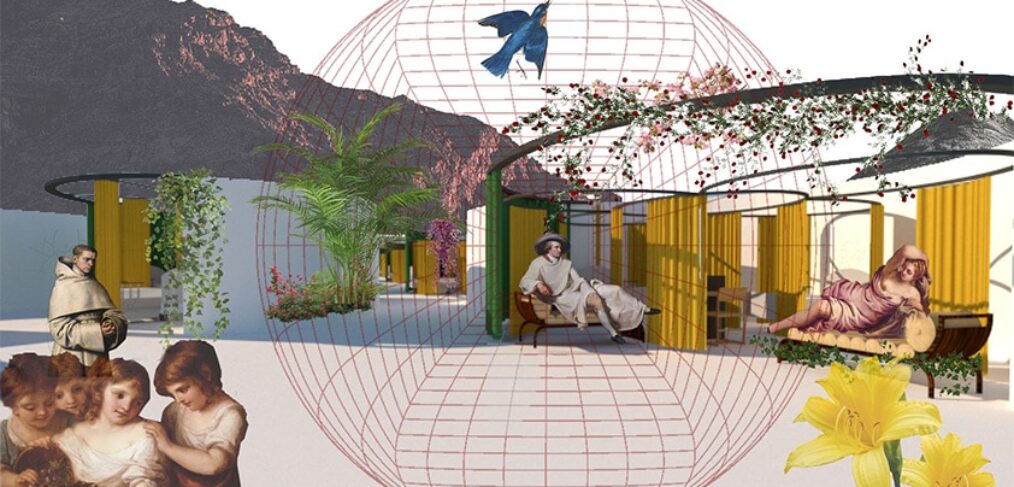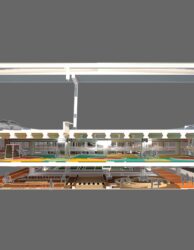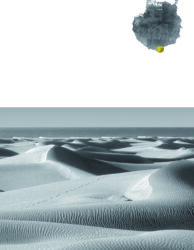
Hospital is not a hospital
Personal Info
Name: Georgios Dionysios Lountzis
Nationality: Greek
Institution / Company: DE|ATH|FORMATION
Instagram: glountzis
Facebook: George Lountzis
LinkedIn: Georgios Dionysios Lountzis
Name: Galini Nikolaidi
Nationality: Greek
Institution / Company: DE|ATH|FORMATION
Instagram: nikol_gal_
Facebook: Γαλήνη Νικολ
-HONOURABLE MENTION of Non Architecture Award 2022 Competition | Category: Aspatial & Virtual
We are in the invisible city of Italo Calvino, Theodora. Through repeated wounds, the city surrendered to the mercy of the Saracens. An invulnerable generation of rodents trapped and poisoned invaded the city, affecting the health of the inhabitants and outlining a new era of pandemic. The city became deserted, the fear of disease became a habit and the inhabitants were trapped in the attempt to find a new immaculate world, under the regime of surveillance. Thus was created the need to design a place for patient care, the place of others. The architects of the city drew inspiration from the symbol of the uroborous serpent, in which the consumption of itself is a symbol of eternity, that is, an eternal oscillation between life and death. The need for outdoor treatment, good nutrition and strict exposure to fresh natural air, turned their attention to coastal and wooded areas, to areas of dynamic release of the inner organic nature of the individual. The vision of a noble community through immersion in nature brought to the surface the proportions of the golden section through a romantic, poetic and biomimetic rendering of a space that can expand and shrink infinitely. The redefinition of a healing area, through biophilic terms, led to the creation of three temporary sites of different scales, which when their stay is over, are unscrewed, disassembled and taken, to be transplanted to the indefinite lands of another half of the city. The first scale refers to a utopian reality, a fractal structure, where the hospital room is shaped by the transfer of elements of private and public space, creating a new state of openness and intimacy. In this way, the patient chooses to be hospitalized in his favorite park, on a sandy beach, in the comfort of his home, etc., thus contributing to the mental and sensory healing of the patient. It is essentially a utopia on the move, based in the city, in the mountains, in the woods, and even on the surface of the sea. The second scale refers to an existing treatment space scenario that adopts the fractal structure and is shaped according to the modern needs of the place of hospitalization, while maintaining naturalistic elements in its design.
The composition consists of three graded zones of functions, such as control, residence and isolation, between which common areas are formed. The above structure is proposed to function supportively in an existing treatment area or as an autonomous unit of intensive care. Finally, the third scale is the reduction and the combination of the two above proposals, aiming at its flexible adaptability to existing spaces, such as museums, airports, schools, etc. After the end of the pandemic, the city returned to its aseptic self, man had redefined his relationship with nature and a forgotten flora had begun to awaken from its lethargy. However, through the rapid increase of the dead bodies, and due to the lack of open public spaces brought about by the depletion, the need for a decent burial emerged, through the change and shrinking of the cemetery, in the face of continuing ecological needs. city’s. The fractal structure therefore passes into public space, creating distances to users and composes a new urban nature in the form of a memory park. The concept of rebirth and reconstruction is attributed to death and disease through the composting of dead bodies. The human body also functions as biomass in a continuous energy cycle, capable of producing light through aerobic biotransformation. Therefore the dead body does not cause disgust and returns to the city in the form of greenery and light, identifying the public space with memory, through the dematerialization of mourning and burial.
Project Type:
Hospital,Conceptual














